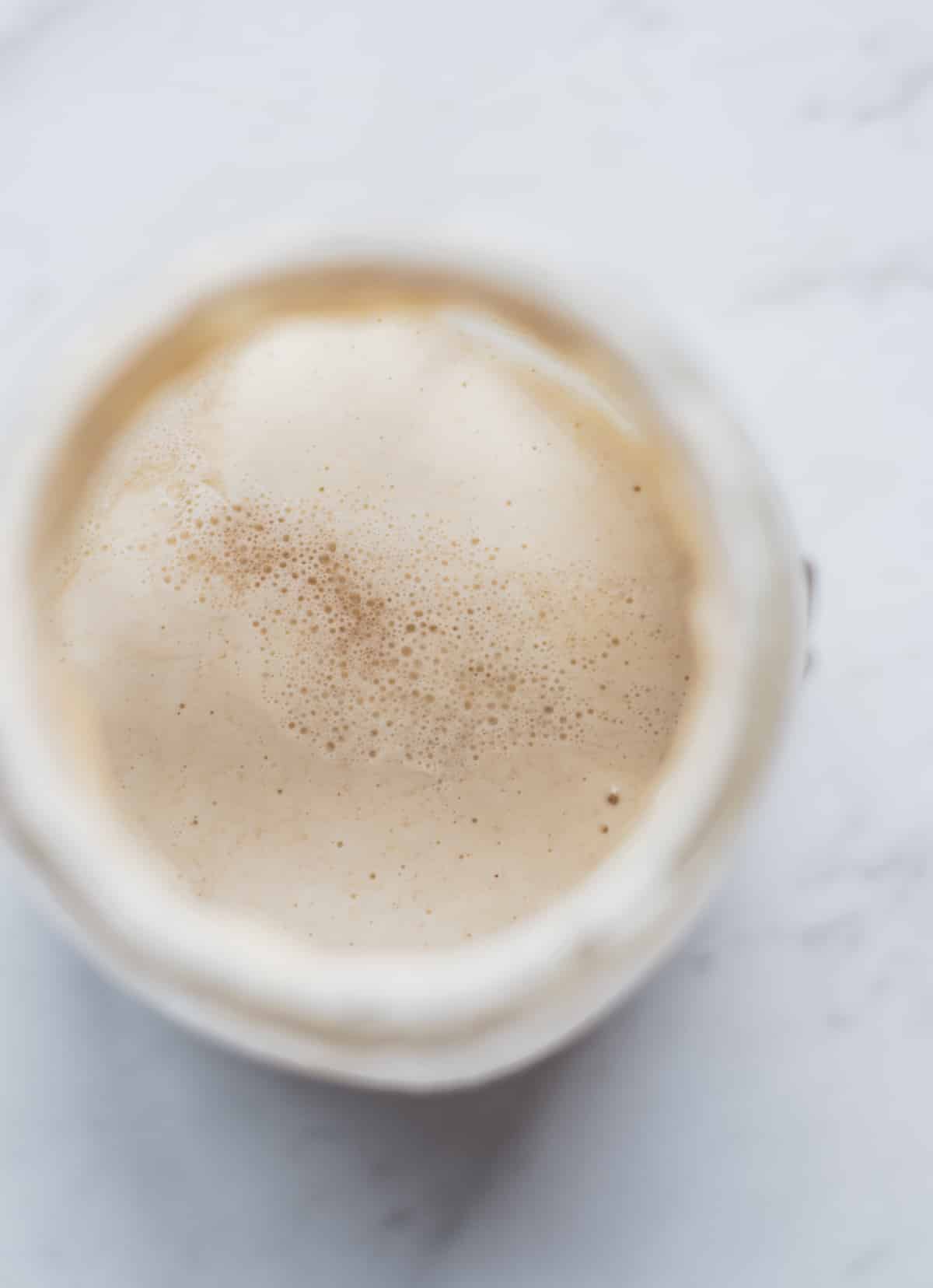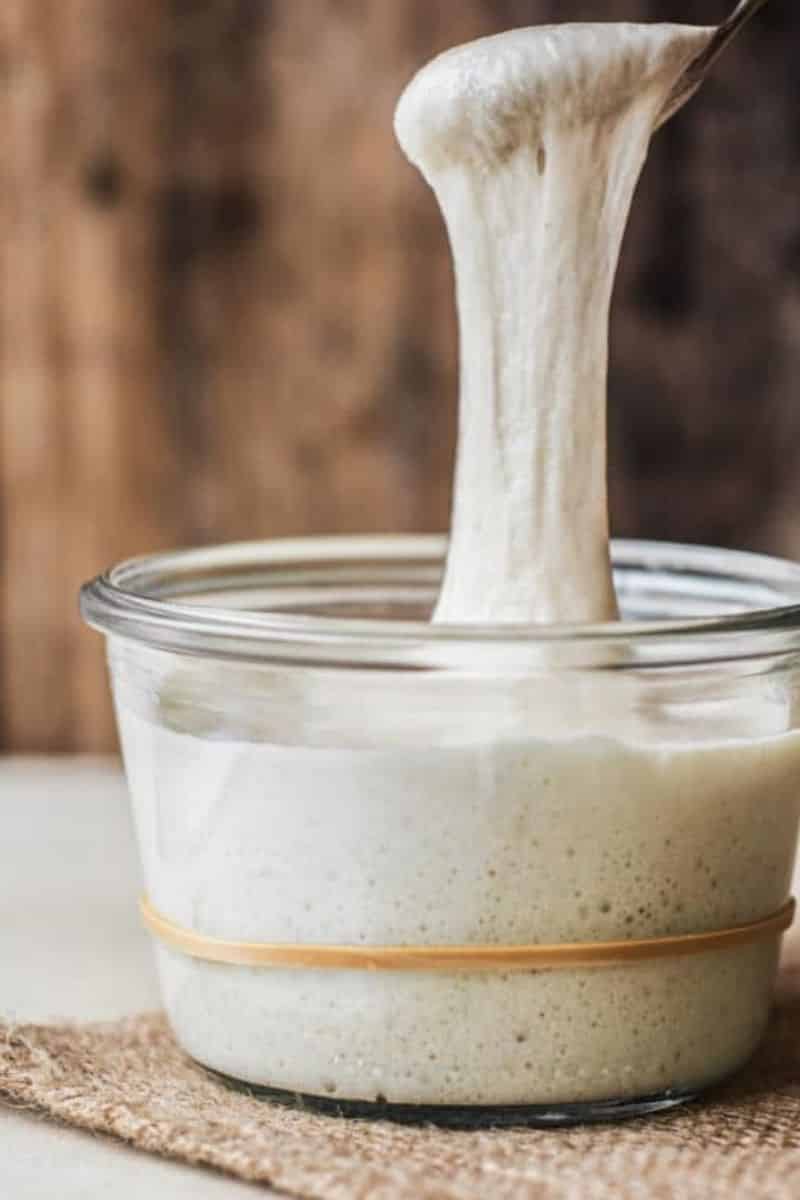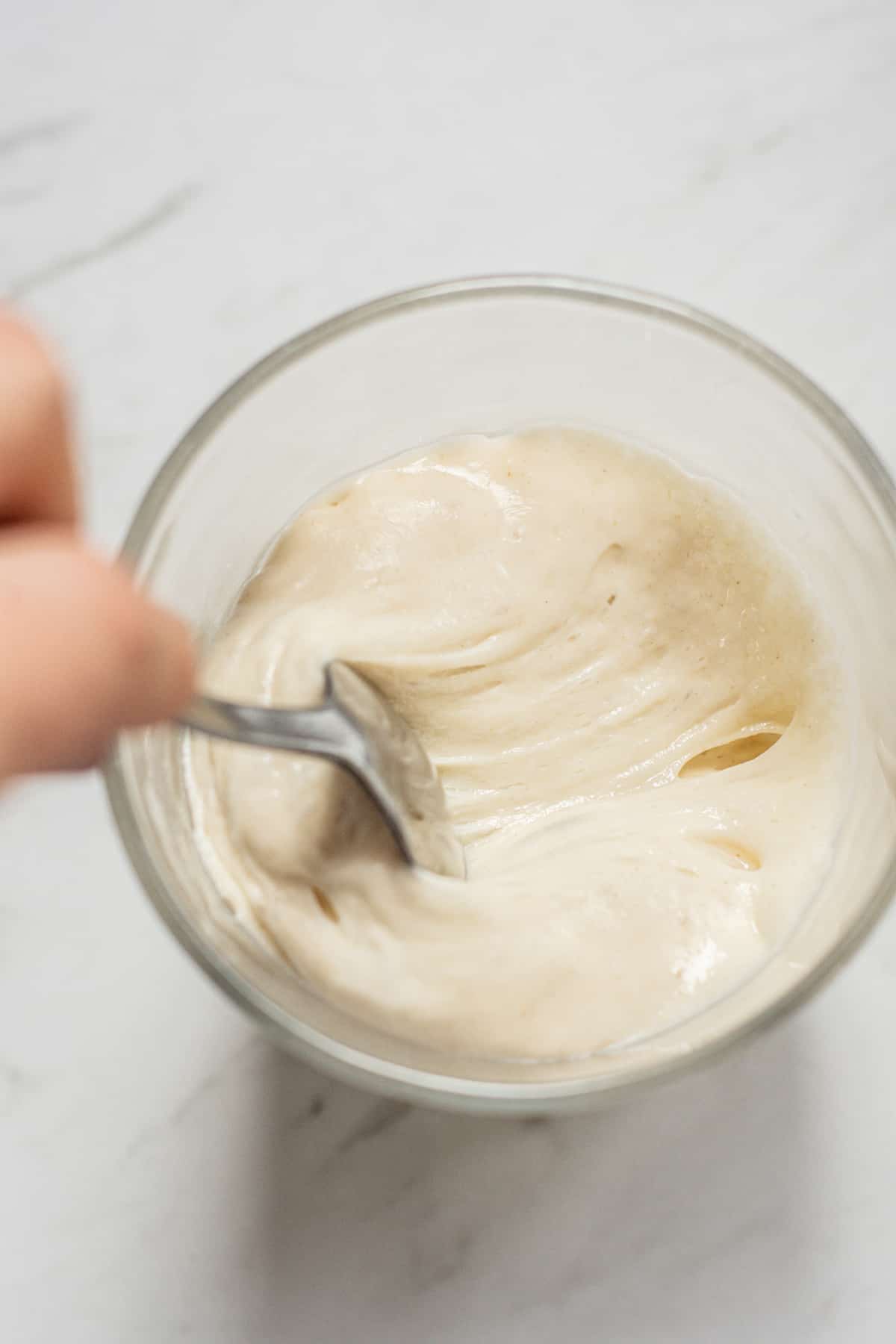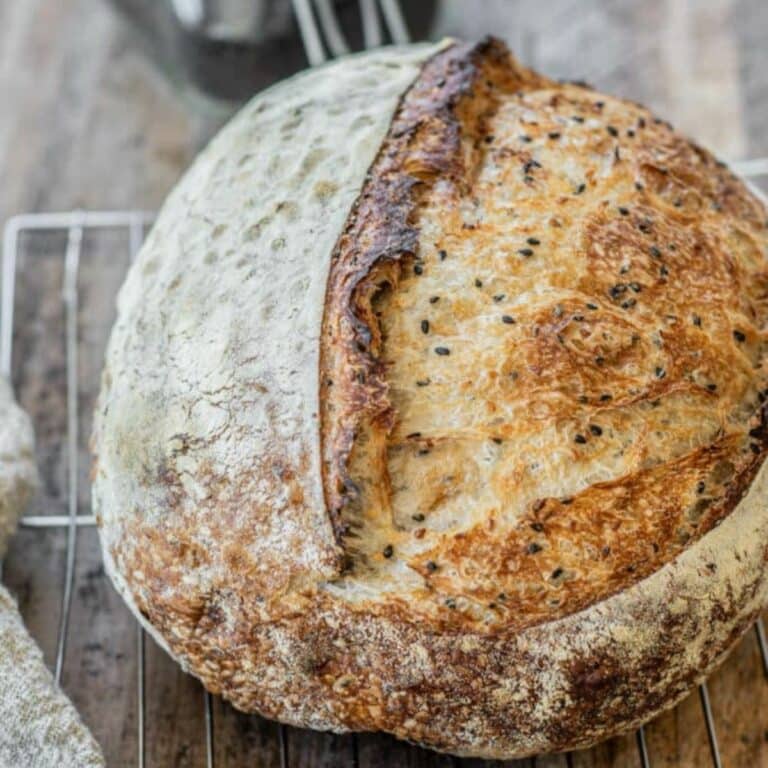Sourdough Starter Not Rising (Plus Other Common Issues)
Sourdough starter not rising? Is something else going wrong? This post addresses common problems of a sourdough starter.
If you’ve got a healthy sourdough starter you can make some amazing sourdough bread and other delicious goodies. However, it’s important to keep your active starter happy and healthy with only good bacteria and yeast.
An active sourdough starter is a collection of wild organisms. Therefore, it’s never a black-and-white process that’s the same for everyone.

It’s a simple process but there are so many variables when it comes to creating a starter. Cold or warmer temperatures, humidity, water, flour, and so forth.
The best thing you can do is observe your own sourdough starter. When you run into a problem you can tweak and test to find what works best for your starter. This post will run through some of the common issues of sourdough starters.
Creating a starter
If you don’t have a sourdough starter yet, check out this sourdough starter recipe and feeding schedule guide. It will run you through the steps to make one. All you need is water and all-purpose flour to make a brand-new sourdough starter.
Sourdough starter not rising
This is a common issue but also a really broad one. The first thing to establish is, how new is the starter.
If your starter is only a few days old then this is really common. It takes a long time for the yeast colony to establish itself in a new starter. Be patient and give it enough time.
Sometimes when a starter is very new it might rise on day one or two, and then stop after that. When a starter is rising that early on it’s usually the bacteria that are causing this, not the wild yeast. You need time to nurture the yeast colonies in order to create a bread dough rise. Rye flour can often cause a bubbly starter initially, due to the bacteria activity.
If your starter is still not rising and it’s been going for a while, there are a few things to check.
Check that:
- The environment isn’t too cold. Keep it at a temperature between 70°F and 80°F (21°C and 26°C). The warmer end of the scale will be faster.
- The environment isn’t too hot. At higher temperatures than 95°F/35°C, the yeast will become dormant.
- Your feeding ratios are correct and you are giving regular feedings. If you have fed your starter too much, or too soon after a previous feed it can slow things down too as it has more food to get through.
- Water. Tap water can often be perfectly fine for sourdough starters but sometimes if there are high amounts of chlorine present it can affect the starter. Use filtered water, or let your tap water sit for 12 hours before using so the chlorine can dissipate.
- Type of flour. Use an unbleached kind of flour. If you’re using bleached flour it can hinder the culture’s growth. You can use all-purpose white flour, bread flour or whole wheat flour.
- One more thing. Check that you aren’t missing the rise. If it’s rising overnight or while you’re out, it may have collapsed. When you’re feeding your starter, mix it in a bowl then add it to a clean jar. Tie a rubber band around the jar to where it reaches. If it rises and falls above the rubber band, you will be able to see marks on the jar.
Sourdough starter smells like alcohol
The smell of alcohol is alcohol forming. It might also have an acetone smell, like nail polish remover. Yeast produces both carbon dioxide and ethanol as it ferments. Ethanol is alcohol.
This is a sign your yeasts have run out of food. Alcohol is always a byproduct of using yeast. However, if your starter smells of it then it’s a sign there’s a lot there. A starter smelling of alcohol (or sometimes acetone) usually has other signs of hunger too. It will be very runny on top of your starter you might see a layer of liquid. This can be a dark liquid or clear.
This can be due to irregular or skipped feeds, starters with too much water, or if your starter environment is at a higher temperature. If it’s very warm, the yeast will work quickly and can run out of food fast.
The good news is that this is very easy to fix. To fix this issue, pour off the liquid and feed your starter regularly. Ensure when feeding your starter that it’s not too thin (using too much water). It may need a few additional feedings if it’s kept in a very warm spot.

Sourdough starter how to feed
Sourdough starter hydration
A 100% hydration starter is a good base for the feeding ratio. This uses equal weights of water and flour. If you’re measuring in volume (say, a 1/4 cup of water and a 1/4 cup of flour,) your starter will be too thin. That’s because there’s a lot more water in weight in a cup than there is flour.
Instead use 1:1:1 or 1:2:2, starter:flour:water. For example, 1:1:1 could be 30 grams of starter, 30 grams of flour, and 30 grams of water. 1:2:2 could be 15g starter, 30g flour, and 30g water. Both these ratios are 100% hydration. Use a kitchen scale for best results.
If your environment is very warm you might need to feed your starter even more regularly. You can also increase the ratio of flour and water. For example, feeding it to 1:3:3 or 1:4:4 (starter:flour: water). This gives the sourdough cultures more of a food source to eat, so they won’t run out too quickly.
You can feed your starter 1-2 times daily if it’s kept at room temperature. An established starter can be kept in the fridge and fed less. Check out this starter feeding post for more information.
Sourdough starter hooch
A sourdough starter hooch is another name for the alcohol that forms on the starter. Once the yeast has run out of food, the alcohol (aka hooch) accumulates on top. Sometimes the color can be really dark grey or even purple depending on how long the starter has been deprived of food.
Pour off the hooch when feeding your starter again. Feed it 1-2 times before using it to bake bread to ensure it’s nice and active.

Sourdough starter smells like vinegar
A healthy sourdough starter has a light sour smell and sour flavor. However, sometimes that goes a step further and it becomes quite a vinegary smell.
The smell of vinegar comes from the bacteria component of the sourdough starter. The lactic acid bacteria (lactobacillus) produce lactic and acetic acid.
The acid produced will depend on the temperature the starter is kept at.
At high temperatures, they produce lactic acid. Lactic acid has a mild sour taste.
At lower temperatures, the bacteria produce acetic acid. This has more of a vinegar-like tang.
It’s normal for the sourdough starter to smell a little acidic. However, if it’s a very strong vinegar smell, your starter needs refreshing. Excess acid can make dough difficult to work with.
To control the acid build-up in a starter, use only small amounts of seed starter when feeding. The seed starter is the amount of starter you will feed fresh flour and water.
A ratio of 1:2:2 or 1:3:3 (starter:flour: water) uses less seed starter than a ratio of 1:1:1. Avoid using more seed starter than fresh flour or water. Refreshing your starter often will help control acid buildup.
In some cases, a starter may smell of vomit. This is due to a build-up of butyric acid and is common in the early stages of making a starter. Just keep feeding your starter regularly.
My sourdough starter has gone bad
Unless it’s a very neglected starter, a sourdough starter that has completely bad is rare. However, sometimes it happens and bad bacteria or mold takes over. If you see mold growing on your starter or it develops a pink, red, or orange tinge, discard it and start again.
Keep up with regular discarding and feeding, in a clean vessel each time. Then your lactobacillus colony will thrive. As they do, the acid they produce will inhibit mold growth and harmful bacteria.
Sourdough starter consistency
The consistency of a sourdough start depends on how you feed it and at what stage of fermentation it is.

A sourdough starter at 100% hydration
When first fed the texture is like a thick cake batter. As it rises it becomes light and airy. Once it has passed its peak and collapsed the sourdough starter will be runny. This is due to the acid and alcohol that have accumulated once the yeast runs out of food.
A stiff starter
A stiff sourdough starter has less water added to it. Usually, it’s half the amount of water to flour. For example, a ratio of 1:2:1 (starter:flour:water). Eg, 20g starter, 40g flour, and 20g water. This makes a stiff dough ball that is kneaded together to combine.
Stiffer starters are slower to rise than those with higher hydration. They undertake a slow but steady growth, with less risk of peaking too early. They are great for enriched doughs like sourdough babka or sourdough cinnamon rolls.
Sourdough starter storage
A starter can be stored at room temperature or in the refrigerator.
Room temperature
When storing it at room temperature, refresh it very regularly. At the 1:1:1 ratio, refresh it 3-4 times every 24 hours. At 1:2:2 or 1:3:3 it may only need one or two refreshes. Keep an eye on your own starter and see how it responds.
Fridge
It can also be refrigerated when it isn’t being used. Feed the starter before placing it in the fridge. Either 1:1:1 if you plan to use it within the next day or two, or 1:2:2 if it will be longer (up to 10 days).
When you’re ready to use it, take it out a day before you need it. Then feed it once or twice to get it active again.
Sourdough starter lid
Cover your starter with a loosely balanced lid, or plastic wrap, or use a cloth. This will help to stop it from drying out and allow gases to escape.
Sometimes the top of a starter will dry out. Pull off the dried top and use what’s underneath. This can happen in a really warm environment. You can avoid this by placing it in a humid spot to rise, or using a lid that can trap moisture, like compostable plastic wrap or beeswax wrap.
A yogurt maker makes a great humid rising spot for a starter. Fill the yogurt maker with warm water and let the starter rise in there.
When refrigerating a starter you can use a sealed lid. The rise and accumulation of gas will be much slower when it’s cold.
Can sourdough starters be frozen?
Sourdough starter can be frozen too, but only once it’s properly mature. Some of the yeast won’t survive the freezing process so there needs to be an established colony.
It can be frozen for up to a year. Once defrosted, give it regular feeds until it’s rising well. This can take 4-7 days.
Happy baking!






Can you make sourdough bread just using the sourdough milk that you by at the supermarket?
Hey Maria, do you by chance mean buttermilk? I have never heard of sourdough milk.
Thanks for posting this – reading of the early days of starter inconsistencies is helpful, as I experienced the quick activity of the first two days and then it went flat (aargh) and you find yourself wondering over a hundred things that might have caused it. Perhaps it was the early bacteria maybe in this case (hadn’t read about before) as you describe. Patience.
Hey Dale, thanks for reading it 🙂 I’m so happy you found it helpful!
Got my live starter yesterday and it’s very thick and sticky and didn’t do anything over night
Hello! It’s day 4 on my starter, and it hasn’t risen at all. This problem occurred yetserday too, and I just thought it was hungry so I fed it. I think I’m experiencing the first 2 days rising so high and the next days it’s flat. Should I continue to feed it or any other advice you have? Thank you!
Just keep feeding it once daily 🙂 the initial rise you saw can be from the bacteria in the mix rather than the yeast. The yeast colony will need longer to establish
Thank you!!
I bought a starter to rehydrate four weeks ago. I followed the instructions that came with it diligently. My starter has a nice sour taste and smells good. However, it has never risen – not even a mm. It is very slow. I have tried 3 different unbleached flours now and I am using bottled spring water. I built a chamber that keeps my starter at 23 degrees celcius constantly. I feed it every morning at roughly the same time using a 1:4:4 ratio. I even tried to boost he starter a week ago by discarding 50% with eache feed. I uave been doing that since but still it is slow and no rise. What am I doing wrong? I’ve read two books, many blogs and articles but just can’t figure it out. Please help
Hey chris, if you are using a 1:4:4 ratio (and I am assuming thats starter:flour:water), then that’s likely too much flour for a starter that still needs establishing. I suggest 1:1:1 until it starts to rise
Thanks so so much! the directions for everything were well explained! So that a 83 yr old grandma could understand….my mama & grandma used to make all our bread items, sour dough of course! so i want to start a starter to make breads for son & grandson…Going to use some of the recipes….thanks so much